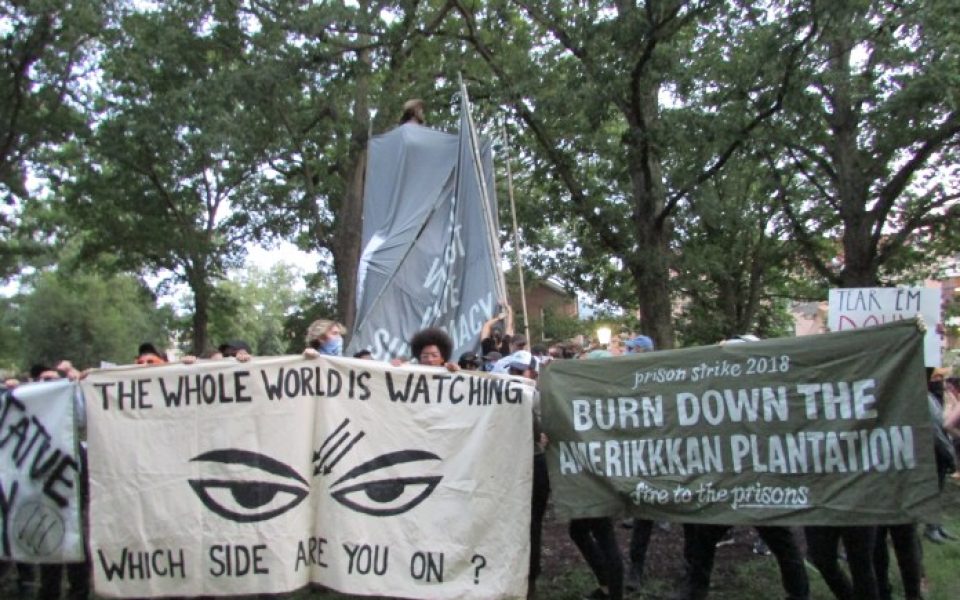The police officers stood around Silent Sam in the inky darkness, watching apprehensively as antifascist students and other protesters advanced.
I jotted some notes, and then when I looked up the officers had vanished and the protesters had taken their place. The atmosphere was charged. Their faces seemed to glow with a kind of invincibility borne of absolute certainty in their cause: the rejection of a symbol of centuries-long violence against and degradation of black lives.
The statue had already been boxed into four towering, slate-gray banners. “For a world without white supremacy,” one declared. The banners formed an enclosure that allowed protesters to move inside undetected, fastening the rope that would eventually wrest the monument from its plinth.
“Tear it down, tear it down,” the crowd yelled.
I hadn’t really believed it was mechanically or logistically possible to remove the statue, although it clearly happened almost a year earlier in Durham. And as a reporter, I hadn’t received a tip-off, or even so much as a hint that it might be worthwhile to stick around. Evidently, most of the people in the crowd didn’t see it coming either, because when the statue toppled the euphoric collective yell sang an admixture of joy and disbelief.
Republican politicians are predictably responding with “law and order” appeals while demonizing antifascists rather than addressing the white supremacist ideology that Silent Sam represents.
“Many of the wounds of racial injustice that still exist in our state and country were created by violent mobs, and I can say with certainty that violent mobs won’t heal those wounds,” Senate President Pro Tem Phil Berger said. “Only a civil society that adheres to the rule of law can heal these wounds, and politicians — from the governor down to the local district attorney — must start that process by ending the deceitful mischaracterization of violent riots as ‘rallies’ and reestablishing the rule of law in each of our state’s cities and counties.”
Notice how Berger’s statement implies that a “violent mob” carried out a “violent riot” in Chapel Hill without specifically stating it. For the record, I did witness protesters and counter-protesters jostling and shoving, and I saw an antifascist protester punch a cop in the cheek during a quick series of tussles when protesters were trying to de-arrest comrades who were defying orders to remove masks. The antifascist protesters were nothing if not cohesive, acting with impressive coordination to hold the space. As to violence against persons, Chancellor Carol Folt said in an official statement that “no one was injured.”
Berger’s response emphasizes form over content. It’s an interesting echo of the current fixation among conservatives on free speech, which includes white nationalists who declare their right to exercise the First Amendment while downplaying the content of their speech.
Linking arms around the statue before they tore it down, the students sang the old Appalachian labor song, “Which Side Are You On?”
Berger, like the administration at the University of North Carolina, is still attempting to maintain a posture of studied neutrality.
Despite his insinuation that the antifascists are a “violent mob,” I am not aware of Berger making any statements denouncing the death threats against Maya Little, the graduate student who protested Silent Sam by pouring red liquid on the statue in April. I have collected multiple screenshots from a Triad-based Confederate fan Facebook page that feature comments like, “Mindless virtue-signaling communist is worthy of stoning.” I have emailed an inquiry to Berger, and look forward to his clarification on how he views these threats.
Little noted during Monday’s rally that Silent Sam was “a memorial to white supremacy and to slave owners, and to people who murdered my ancestors.” Along with being a continual reminder of the degradation of black people, the unresolved tension surrounding the monument created an atmosphere that compromised students’ safety.
What responsibility do Berger and his fellow Republican legislators bear for threats to safety experienced by students of color and white antiracist accomplices? Actually, quite a lot.
After Dylann Roof massacred nine black parishioners at Mother Emanuel church in Charleston, SC in June 2015 and pressure mounted for the removal of Confederate flags and monuments, Republican lawmakers in North Carolina rushed to enact a new law banning state agencies and local governments from taking down any “object of remembrance” on public property that “commemorates an event, a person, or military service that is part of North Carolina’s history.” What more proof could be needed that Confederate symbols are an incitement to violence than the photo of Roof holding a Confederate flag and his admission that he wanted to start a race war?
Thus, when another white supremacist terrorist attack occurred in Charlottesville in August 2017, cities from Baltimore to Lexington, Ky. quickly removed Confederate monuments, along with the University of Texas at Austin. But the administration at the University of North Carolina, meanwhile, was effectively bound by law.
The students in Chapel Hill acted on Monday night, clearly and unequivocally rejecting white supremacy.
They demanded to know: Which side are you on? Silence is its own answer.
Join the First Amendment Society, a membership that goes directly to funding TCB‘s newsroom.
We believe that reporting can save the world.
The TCB First Amendment Society recognizes the vital role of a free, unfettered press with a bundling of local experiences designed to build community, and unique engagements with our newsroom that will help you understand, and shape, local journalism’s critical role in uplifting the people in our cities.
All revenue goes directly into the newsroom as reporters’ salaries and freelance commissions.


Leave a Reply